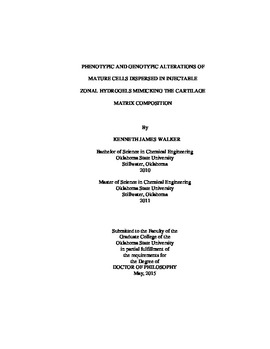| dc.contributor.advisor | Madihally, Sundararajan | |
| dc.contributor.author | Walker, Kenneth James | |
| dc.date.accessioned | 2016-09-29T18:37:22Z | |
| dc.date.available | 2016-09-29T18:37:22Z | |
| dc.date.issued | 2015-05 | |
| dc.identifier.uri | https://hdl.handle.net/11244/45215 | |
| dc.description.abstract | Cartilage is a soft multilayered tissue found in the articular capsule of joint areas. Physical activity and osteoarthritis (OA) can damage and deteriorate the avascular, metabolically low tissue. Because of this, chondrocytes are incapable of regenerating cartilage tissue when a defect occurs. Therefore, regenerative therapies incorporating the fundamental concepts of tissue engineering are required to repair the damaged cartilage. Previous efforts employed the use of highly invasive surgical procedures and 3D isotropic scaffolds, many of which lacked similarity to native cartilage composition. This research focused on two main areas i) the importance of cartilage composition for designing scaffolds, ii) the involvement of physical and chemical factors on promoting growth, differentiation, and biological function of cells. Chitosan-based zonal hydrogel scaffolds were designed for three out of the four layers of cartilage ranging from the superficial zone (chondrocytes) to the calcified zone (osteoblasts with the biochemical composition of cartilage in mind. Mechanical, physical, rheological properties of the hydrogels were assessed. Additionally, the hydrogels were subcutaneously injected into the dorsal area of mice to observe the immune responses and gelation characteristics of the hydrogels in an in vivo environment. Since chondrocytes are not a viable source due to low metabolism and stem cell sources come with an array of problems as well. Therefore, this research explored the use of human foreskin fibroblasts in chondrogensis and osteogenesis. The zonal hydrogels were used with chemical stimulus from differentiation medium to induce chondrogenesis and osteogenesis on the fibroblasts. The cultures analyzed using genotypic and phenotypic analyses to fully assess the quality of the tissue produced and the transformation of the fibroblasts into the chondrogenic and osteogenic lineages. Anisotropy was achieved through sequential layering of the hydrogels. Further the absent cartilage zone was created during the layering process. Hydrogel gelation was observed upon injection, and the hydrogels were also observed to be stable in the in vivo mouse models and retain shape throughout the duration of the study. The genotypic and phenotypic analyses of the induction cultured were suggestive of fibroblast transformation into the chondrogenic and osteogenic lineages. | |
| dc.format | application/pdf | |
| dc.language | en_US | |
| dc.rights | Copyright is held by the author who has granted the Oklahoma State University Library the non-exclusive right to share this material in its institutional repository. Contact Digital Library Services at lib-dls@okstate.edu or 405-744-9161 for the permission policy on the use, reproduction or distribution of this material. | |
| dc.title | Phenotypic and genotypic alterations of mature cells dispersed in injectable zonal hydrogels mimicking the cartilage matrix composition | |
| dc.contributor.committeeMember | Foutch, Gary | |
| dc.contributor.committeeMember | Ruhl, Donald | |
| dc.contributor.committeeMember | Smay, James | |
| osu.filename | Walker_okstate_0664D_13935.pdf | |
| osu.accesstype | Open Access | |
| dc.type.genre | Dissertation | |
| dc.type.material | Text | |
| thesis.degree.discipline | Chemical Engineering | |
| thesis.degree.grantor | Oklahoma State University | |
